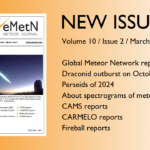Like in 2015 significant activity has been detected from the Gamma Lyrids (794) by CMOR in 2018, but thus far no orbits could be found in the CAMS BeNeLux data (until 6 February 2018) although clear sky allowed collecting a large number of orbits.
Introduction
A search on 2013-2016 CMOR orbits resulted in the detection of the Gamma Lyrids (GLY-794) at λʘ = 316° in 2015. No earlier evidence for this shower has been found in any year from 2002–2014 in CMOR data (Brown, 2016). A spread in vg of 2 km/s in velocity and 2.7° on the radiant position was found with an activity lasting less than 2 days. The orbit is typical for a Halley type comet but no parent body could be associated yet.
On 2015 February 5, 10h–11h UT amateur radio observers reported an outburst, one of them the Belgian amateur Lucas Pellens (Steyaert, 2015). CAMS BeNeLux had 38 cameras collecting orbits in the nights of 2015 February 4-5, 5-6 and 6-7 but not any single orbit matches with the GLY-794 orbit (Roggemans, 2015).

Figure – 1 CMOR image at 2018 February 06 at 18h15m UT showing one concentrated radiant activity at the position of the GLY-794 shower.
And again in 2018
The GLY-794 appeared to be an annual shower in the radar data, but did not come forward in any orbit search on meteors in the visual range. Also 2018 data for CAMS BeNeLux revealed no orbits for this shower. The remarkable absence in the visual range stands in great contrast to the strong appearance as radiant source for the orbits detected by CMOR (Figure 1). I checked the available datasets and I could not find any single resembling orbit in the SonotaCo data sets, nothing in the Croatian Meteor Network (CMN) datasets, nothing in the Photographic orbit catalogue and nothing in the Harvard radar meteor orbit list 1961-1965 and 1968-1969. One single orbit which qualifies for the GLY-794 shower was found in EDMOND (Kornos et al., 2014). A single meteor recorded on 6 February 2012 compares well to the reference orbit, but indeed a single meteor doesn’t prove a meteor stream.
Table 1 – The available orbits for the Gamma Lyrids (794), all data referring to J2000.0.
| Brown (2016) | Jenniskens et al. (2017) | EDMOND05_v03
2012/02/06 |
|
| λʘ (°) | 316.5 | 317 | 316.6 |
| α (°) | 285 | 287.0 | 287.1 |
| δ (°) | 33.7 | 35.5 | 32.8 |
| vg (km/s) | 37 | 33.5 | 35.7 |
| a | – | 5.99 | 16.6 |
| q | 0.78 | 0.795 | 0.766 |
| e | 0.992 | 0.867 | 0.954 |
| ω (°) | 125.7 | 125.6 | 122.9 |
| Ω (°) | 316.5 | 317.0 | 316.6 |
| i (°) | 54.6 | 49.9 | 52.1 |
| N | 32 | 2 | #2854 |
References
Brown P. (2016). “Recent shower outbursts detected by the Canadian Meteor Orbit Radar (CMOR)”. In Roggemans A. and Roggemans P., editors, Proceedings of the International Meteor Conference, Egmond, the Netherlands, 2-5 June 2016. IMO, pages 42–45.
Jenniskens et al. (2017). Sumitted to Icarus 2017.
Kornoš L., Matlovič P., Rudawska R., Tóth J., Hajduková M. Jr., Koukal J., and Piffl R. (2014). “Confirmation and characterization of IAU temporary meteor showers in EDMOND database”. In Jopek T. J., Rietmeijer F. J. M., Watanabe J., Williams I. P., editors, Proceedings of the Meteoroids 2013 Conference, Poznań, Poland, Aug. 26-30, 2013. A.M. University, pages 225–233.
Roggemans P., Johannink C. And Breukers M. (2015). “Status of the CAMS-BeNeLux network”. In Rault J.-L. and Roggemans P., editors, Proceedings of the International Meteor Conference, Mistelbach, Austria, 27-30 August 2015. IMO, pages 41-50.
Steyaert (2015). “The 2015 February 5 event”. In Rault J.-L. and Roggemans P., editors, Proceedings of the International Meteor Conference, Mistelbach, Austria, 27-30 August 2015. IMO, pages 73-77.


